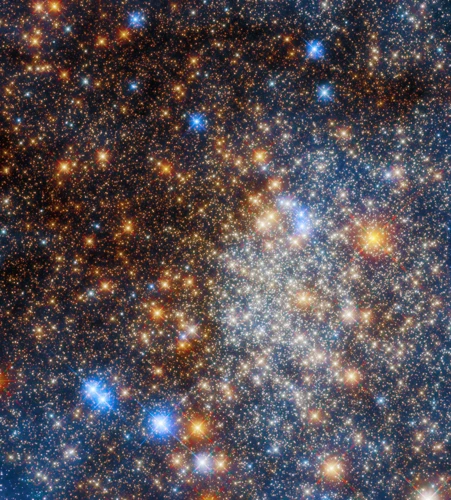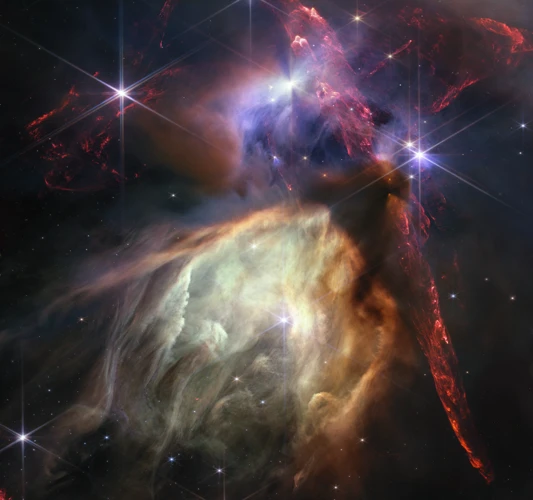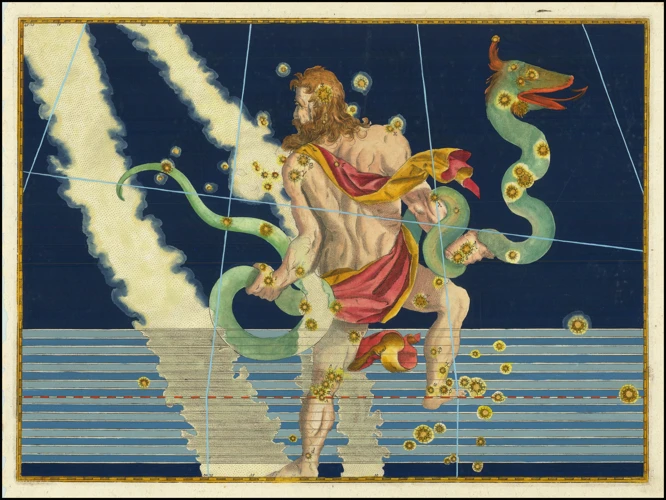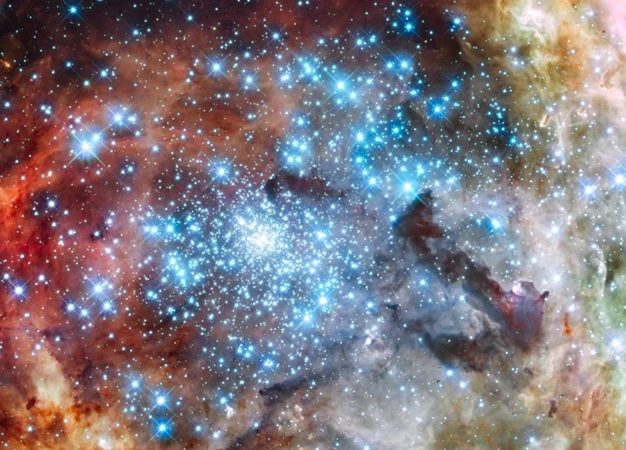Have you ever looked up at the night sky and wondered why some stars appear red, while others shine with a brilliant blue hue? The colors of stars may seem random, but in reality, they hold fascinating secrets about the nature and characteristics of these celestial objects. By delving into the science behind star colors, we can unlock a wealth of information about their temperature, chemical composition, spectral types, and even their life cycles. In this article, we will explore these mysteries and discover the hidden meanings behind the colors that adorn the vast expanse of our universe. So, grab your telescope and join us on this captivating journey through the secrets of the colors of stars.
The Science of Star Colors

The Science of Star Colors can be attributed to several factors, including temperature and chemical composition. Temperature plays a significant role in determining the color of a star. The hotter the star, the bluer its color appears, while cooler stars take on a reddish hue. Understanding the Kelvin Scale is essential in comprehending this relationship. Stars with temperatures above 10,000 Kelvin emit predominantly blue light, while those below 3,000 Kelvin emit mostly red light. The spectrum of temperature in between produces a range of colors, from yellow and orange to white. Another crucial factor is the chemical composition of a star. Different elements present in a star’s atmosphere absorb and emit light at specific wavelengths, affecting its color. For instance, the presence of helium can cause a star to appear more yellow. Additionally, the abundance of certain elements, referred to as metallicity, can influence the color of stars. Higher metallicity can lead to redder stars, while lower metallicity can result in bluer stars. The science of star colors is a fascinating field that allows astronomers to study and understand the characteristics and evolution of these captivating celestial objects.
The Role of Temperature in Stellar Color

The Role of Temperature in Stellar Color is a fundamental aspect of understanding the intriguing world of stars. Temperature plays a significant role in determining the color we observe from a star’s luminous glow. Stars emit light across a wide range of wavelengths, and the distribution of this light is directly influenced by their temperature. Hotter stars, with temperatures above 10,000 Kelvin, tend to radiate predominantly blue light, giving them a bluish-white appearance. Cooler stars, on the other hand, with temperatures below 3,000 Kelvin, emit predominantly red light, giving them a reddish hue. The spectrum of temperature in between produces a variety of colors, including yellow, orange, and white. By analyzing the color of a star, astronomers can determine its temperature and gain valuable insights into its characteristics and stage of evolution. From the scorching blue glow of young protostars to the fiery red hues of dying supernovae, temperature holds the power to unlock the secrets hidden within the captivating colors of the stars above.
Understanding the Kelvin Scale
Understanding the Kelvin Scale is crucial in unraveling the mysteries of star colors. The Kelvin Scale, named after the physicist William Thomson, measures temperature on an absolute scale. Unlike the Celsius or Fahrenheit scales, which have the freezing point of water as their starting point, the Kelvin Scale begins at absolute zero, the point at which molecular motion ceases entirely. This scale allows scientists to accurately measure the temperatures of celestial objects, including stars. Stellar temperatures are typically expressed in Kelvin, with the hottest stars reaching tens of thousands of degrees Kelvin. By understanding the Kelvin Scale, astronomers can determine the temperature of a star and correlate it to its color. Knowing the temperature of a star not only provides insight into its physical properties but also aids in identifying its stage of evolution, from hot blue protostars to red giants on the brink of stellar death. The Kelvin Scale is an indispensable tool that enables astrophysicists to delve deeper into the celestial realm and uncover the fascinating connection between stars and the cosmos.
Red Hot, Blue Cold: The Temperature Spectrum
The temperature spectrum plays a crucial role in determining the colors of stars, ranging from red-hot to blue cold. At one end of the spectrum, we have the hottest stars, which emit predominantly blue light. These stars, known as blue giants or blue supergiants, can have surface temperatures exceeding 30,000 Kelvin. Their intense heat causes them to radiate high-energy photons, resulting in their characteristic blue appearance. Moving along the spectrum, we encounter stars classified as white or yellow-white, such as our own Sun. With temperatures ranging from around 5,500 to 6,000 Kelvin, these stars emit a balanced spectrum of light, appearing relatively white. As we approach the cooler end of the spectrum, we find stars that exhibit a distinct reddish color. These stars, often referred to as red dwarfs, have temperatures ranging from about 3,000 to 4,000 Kelvin. The lower temperature causes their peak emission to shift towards the red end of the visible spectrum. The diverse range of temperatures in the stellar realm contributes to the mesmerizing array of colors we witness in the night sky. Understanding this temperature spectrum enables astronomers to classify stars based on their color and gain insights into their characteristics and evolutionary stages.
Chemical Composition and Its Effect on Star Colors

The color of a star is not solely determined by its temperature but also by its chemical composition. Different elements present in a star’s atmosphere can have a significant effect on its color. For example, stars with a higher abundance of helium may appear more yellow, while the presence of other elements like carbon or oxygen can give a star a red hue. The unique spectral lines emitted by these elements influence the wavelengths of light that reach our eyes and contribute to the overall color perception of the star. The concept of metallicity, which refers to the abundance of elements heavier than hydrogen and helium, plays a role in coloring stars. Stars with higher metallicity tend to have a redder color, while those with lower metallicity can exhibit a bluer hue. By analyzing the chemical composition of stars, astronomers can gain valuable insights into their formation, evolution, and even their connection to ancient mythology. For more information about the fascinating link between stars and ancient mythology, you can explore our article on the fascinating connection between stars and ancient mythology.
Red Giants and Yellow Dwarfs: The Influence of Chemical Elements
Red Giants and Yellow Dwarfs are two types of stars that showcase the influence of chemical elements on their color. Red Giants are massive, evolved stars that have exhausted their core hydrogen fuel. These giants have expanded and cooled, becoming much larger and redder than their main sequence counterparts. The red color of these stars is a result of the presence of chemical elements such as carbon and nitrogen in their outer layers. These elements absorb blue and green light, causing the star to emit mostly red light.
In contrast, Yellow Dwarfs are main sequence stars, similar to our Sun. These stars have a yellowish color, which is primarily due to the elements present in their atmospheres. The most abundant element in these stars is hydrogen, which emits predominantly in the blue and red regions of the spectrum. However, the presence of other chemical elements such as helium, carbon, and nitrogen can influence the color. The proportion of these elements affects the absorption and emission of light, resulting in a yellow appearance. The mixture of different elements in the star’s outer layers creates a complex interaction of wavelengths, producing the characteristic yellow color.
Understanding the influence of chemical elements on the colors of stars provides invaluable insights into their composition, evolution, and overall behavior. By analyzing the specific elements present in a star’s spectrum, astronomers can determine its evolutionary stage and make inferences about its future. This knowledge goes hand in hand with the role of astrophysics in studying the formation and evolution of stars, as it allows scientists to unravel the intricacies of stellar life cycles. Observing and deciphering the colors of stars opens up a world of understanding about the vastness and complexity of our universe.
The Role of Metallicity in Coloring Stars
The Role of Metallicity in Coloring Stars is a fascinating aspect of stellar science. Metallicity refers to the abundance of elements heavier than helium in a star’s composition. It has a direct impact on the color of stars. Stars with higher metallicity tend to have a redder appearance, while stars with lower metallicity appear bluer. This is because metallicity affects the opacity of a star’s atmosphere, which in turn influences the absorption and scattering of light. High metallicity leads to the presence of more metallic elements, causing the star’s atmosphere to absorb more blue light and transmit more red light, resulting in a redder color. On the other hand, low metallicity reduces the amount of absorption, allowing more blue light to pass through, giving the star a bluer hue. Metallicity plays a crucial role in stellar evolution and provides valuable information about a star’s history. It can indicate the age of a star and even provide insights into its formation and evolution. Astrophysicists study metallicity in stars to understand the chemical processes occurring within them and to unravel the mysteries of stellar life cycles. By analyzing the metallicity of stars, scientists can gain a deeper understanding of the universe and the intricate interconnectedness of its celestial entities.
Spectral Types and Their Color Classifications

Spectral Types and Their Color Classifications provide a comprehensive system for categorizing stars based on their color and spectral characteristics. This classification, also known as the stellar color alphabet, consists of seven main categories: O, B, A, F, G, K, and M. Each spectral type represents a specific range of temperatures and colors. O-type stars are the hottest and appear bluish, while M-type stars are the coolest and display a reddish hue. The HR Diagram, a powerful tool in astrophysics , further unveils the secrets of spectral types by plotting stars’ luminosity against their surface temperature. This diagram helps astronomers understand how stars evolve and the relationship between temperature, color, and other properties. By studying spectral types and their color classifications, scientists can gather crucial information about the nature and life cycle of stars, contributing to our understanding of the vast and captivating universe.
O, B, A, F, G, K, M: The Stellar Color Alphabet
The Stellar Color Alphabet, consisting of O, B, A, F, G, K, and M, categorizes stars based on their spectral types and color classifications. Each letter represents a specific range of surface temperatures and colors. The hottest and bluest stars are classified as type O, with temperatures above 30,000 Kelvin. These stars emit intense ultraviolet radiation and typically appear blue in color. Moving down the temperature scale, type B stars are slightly cooler and appear blue-white. Type A stars follow, with a more white coloration. F-type stars give off a yellow-white light, while G-type stars, like our sun, exhibit a yellow color. Cooler K-type stars appear orange, while the coolest and reddest stars fall under the category of M-type. These classifications allow astronomers to understand the temperature, color, and evolutionary stage of stars, providing valuable insights into their life cycles. By studying the Stellar Color Alphabet, scientists can unravel the mysteries of our universe and expand our knowledge of celestial objects.
The HR Diagram: Unveiling the Secrets of Spectral Types
The HR Diagram, also known as the Hertzsprung-Russell Diagram, is a powerful tool in unraveling the secrets of spectral types and understanding the lives of stars. This diagram represents the relationship between a star’s luminosity (brightness) and its surface temperature. By plotting stars on this diagram, astronomers can categorize them into different spectral types. The x-axis represents the temperature of a star, ranging from hot on the left to cool on the right. The y-axis represents the luminosity, with brighter stars towards the top and dimmer stars towards the bottom. The HR Diagram allows astronomers to identify different regions, such as the main sequence, where most stars, including our Sun, reside. Stars of different spectral types, ranging from O to M, occupy distinct regions within this diagram. For example, blue giants and supergiants dominate the top left, while red dwarfs populate the bottom right. The HR Diagram provides critical insights into a star’s stage of evolution, its mass, and even its potential fate. This diagram revolutionized our understanding of stellar astronomy and continues to be a valuable tool in astrophysical research. If you want to learn more about studying stars, check out our guide on how to use a telescope.
The Colorful Lives of Binary Stars

Binary stars, which consist of two stars orbiting around a common center of mass, lead colorful lives in more ways than one. The dance of color in binary systems is a mesmerizing sight, as the two stars often have different colors due to variations in temperature and chemical composition. One star may appear blue, while its companion shines with a reddish tint. The presence of close stellar companions can significantly impact the color of a star. The gravitational interaction between the stars can cause them to exchange mass, altering their chemical composition and affecting their color. This dynamic relationship between binary stars provides valuable insights into their formation and evolution. By studying these vibrant systems, astronomers can uncover secrets about stellar evolution and the intricate interplay between celestial bodies. It is truly a captivating realm that continues to astonish and inspire astronomers in their quest for knowledge about the wonders of the universe.
The Dance of Color in Binary Systems
The Dance of Color in Binary Systems is a mesmerizing display of celestial choreography. Binary star systems consist of two stars that orbit around a common center of mass. These stellar pairs can vary in their color combinations, creating a captivating visual spectacle. The color of each individual star in a binary system is determined by its temperature and chemical composition, but their combined appearance can change as they orbit each other. As the stars orbit, they undergo various interactions and gravitational influences, causing their colors to shift. This phenomenon, known as the Doppler effect, can result in what is called a spectroscopic binary, where the colors of the stars appear to shift towards the blue or red end of the spectrum as they move towards or away from Earth. This color shift provides valuable information about the motion and orbital characteristics of the binary system. In some cases, the stars may even exchange mass, altering their individual colors and intensities. The intricate dance of color in binary systems offers astronomers unique insights into the dynamics and evolution of these stellar pairs. By studying the changing colors and behaviors of these systems, scientists can uncover clues about their formation, stability, and eventual fate. The Dance of Color in binary systems truly exemplifies the beauty and complexity of the stellar world.
The Impact of Close Stellar Companions on Color
The Impact of Close Stellar Companions on Color is a fascinating aspect of star systems. When two stars are in close proximity and orbit each other, their gravitational interaction can have a significant influence on their colors. This phenomenon is known as a binary star system. In a binary system, the stellar companions can transfer mass between them, leading to changes in their temperature, size, and luminosity. As a result, the colors of the stars can vary over time. For example, if one star is more massive and hotter than the other, it can transfer mass to the cooler star. This mass transfer can cause the cooler star to become larger and more luminous, changing its color to a brighter shade. On the other hand, if the cooler star is more massive, it can strip material from the hotter star, causing the hotter star to become smaller and less luminous. This can result in a shift in color towards a dimmer shade. The intricate dance of color in binary systems provides astronomers with valuable insights into the evolution and dynamics of these stellar pairs. It allows them to study the effects of mass transfer, tidal interactions, and even mergers between stars. The Impact of Close Stellar Companions on Color unveils another layer of complexity in the fascinating world of stellar systems.
Unusual Colors and Their Significance

Unusual Colors in stars hold significant meaning in the world of astronomy. While stars commonly exhibit colors ranging from blue to red, there are exceptional cases that give rise to peculiar hues. White and Black Dwarfs, for example, represent extremes in star color. White Dwarfs are incredibly dense, leftover remnants of stars that have exhausted their nuclear fuel. They appear white due to their high temperature but lack the vibrant colors associated with active stars. On the other end of the spectrum, Black Dwarfs are the end stage of a White Dwarf that has cooled down completely, emitting no visible light. Another intriguing group of stars are Brown Dwarfs, which occupy a mysterious space between planets and stars. These “failed stars” have insufficient mass to sustain nuclear fusion, causing them to emit a faint, reddish glow. Exploring these unusual colors allows astronomers to learn more about the different stages and outcomes in the life cycles of stars, providing valuable insights into the vast and diverse cosmos.
White and Black Dwarfs: The Extremes of Star Color
White and Black Dwarfs are the extremes of star color, representing two intriguing ends of the spectrum. White dwarfs are the remnants of stars that have exhausted their nuclear fuel and shed their outer layers, leaving behind a dense core composed mainly of carbon and oxygen. These stellar remnants have a white or bluish-white color, which is a result of their high surface temperatures, typically around 10,000 to 30,000 Kelvin. Despite their high temperatures, white dwarfs are relatively dim compared to main-sequence stars, due to their small size and lack of energy production.
On the other end of the spectrum, Black dwarfs represent the end stage of a white dwarf’s life cycle. Over billions of years, white dwarfs cool down and fade away, eventually becoming black dwarfs. These stellar remnants have low temperatures, around a few thousand Kelvin, causing them to emit very little light or heat. Black dwarfs are theoretical objects that have not yet been observed since the Universe is not old enough for them to have completely cooled. Nevertheless, they hold a place in astrophysics theory as the final stage of low-mass stars’ evolution.
These extremes of star color, from the hot white dwarfs to the almost undetectable black dwarfs, provide crucial insights into the life cycles and characteristics of stars. By studying the colors and properties of these stellar remnants, astronomers can further our understanding of stellar evolution, the mechanisms of energy production within stars, and the fate of low-mass stars in the long cosmic timescales.
Related links:
– Learn more about the how to use a telescope to observe celestial objects like white dwarfs and black dwarfs.
– Discover the fascinating connection between stars and ancient mythology and how cultures from around the world interpreted star colors.
– Understand the essential role of astrophysics in studying the formation and evolution of stars and unraveling the secrets of their colors.
Brown Dwarfs: Not Quite Stars, Not Quite Planets
Brown dwarfs are intriguing objects that fall somewhere between stars and planets in terms of their characteristics. Unlike stars, brown dwarfs do not possess enough mass to sustain nuclear fusion in their cores, which is the process that powers the intense radiation and heat of stars. As a result, brown dwarfs do not emit the same level of light and heat as stars do. This limited radiation causes them to have a unique coloration, appearing faint and reddish in the night sky. The exact color of a brown dwarf can vary depending on factors such as its age and atmospheric conditions. Younger brown dwarfs tend to have a redder color, while older ones can become cooler and transition to a bluer or even a magenta hue. The distinct color of brown dwarfs helps astronomers identify and classify them among other celestial objects. This classification is crucial in understanding the formation and evolution of these objects, which share some characteristics with both stars and planets. Brown dwarfs are compelling subjects of study that contribute to our understanding of the diverse range of objects that populate our universe.
Color as a Clue to a Star’s Life Cycle
Color serves as a valuable clue to deciphering a star’s life cycle. By observing the colors of stars, astronomers can gain insights into their evolutionary stage and eventual fate. For instance, protostars in the early stages of formation tend to appear as glowing, hot blue objects. As they mature, they progress through different color stages, reflecting changes in temperature and chemical composition. The majority of main-sequence stars, like our sun, have a yellowish or whitish color. Red giants, on the other hand, have expanded and cooled, giving them a reddish hue. The massive stars that explode as supernovae, leaving behind remnants like white dwarfs, neutron stars, or black holes, exhibit distinct color characteristics depending on their mass and composition. By analyzing star colors and their corresponding stages, scientists can piece together a narrative of stellar evolution and unravel the mysteries of the cosmos.
From Hot Blue Protostars to Red Exploding Supernovae
From Hot Blue Protostars to Red Exploding Supernovae, the colors of stars provide valuable insights into their life cycles. Let’s start with protostars, which are young, newly formed stars. These protostars are incredibly hot and emit a blue color. As they continue to evolve, their temperature gradually decreases, causing their color to shift towards the red end of the spectrum.
Moving along the stellar life cycle, we encounter main sequence stars. These stars, like our Sun, emit a yellow or white color. They have reached a stable state where the inward gravitational force is balanced by the outward pressure generated through nuclear fusion.
As stars age, they may expand and cool, becoming red giants. These aging stars emit a red color due to the lower temperatures at their surfaces. The transformation from a main sequence star to a red giant occurs when a star exhausts its core hydrogen fuel and begins to burn heavier elements.
But what happens when a massive star nears the end of its life? The answer lies in the explosion of a supernova. Supernovae emit a brilliant red color that can outshine an entire galaxy. This explosion occurs when the star’s core collapses, resulting in a massive release of energy. The red color is a result of the extreme temperatures and energy released during this cataclysmic event.
Beyond supernovae lie remnants such as white dwarfs, neutron stars, and black holes. White dwarfs, the remnants of low to medium mass stars, appear white rather than red. Neutron stars, on the other hand, emit a faint red glow due to their high density and intense magnetic fields. Finally, black holes, although they do not emit any visible light, are often surrounded by accretion disks that can produce colorful emissions.
The colors of stars provide a window into their life cycles. From hot blue protostars to red exploding supernovae, each stage presents a unique color that reflects the physical processes occurring within the star. By studying these colors, astronomers can unravel the mysteries of stellar evolution and gain a deeper understanding of the universe we inhabit.
The Colorful Demise of Stars: White Dwarfs, Neutron Stars, and Black Holes
The Colorful Demise of Stars: White Dwarfs, Neutron Stars, and Black Holes takes us into the thrilling final stages of a star’s life cycle. When a star exhausts its nuclear fuel, it undergoes dramatic transformations, resulting in different celestial objects with unique colors.
1. White Dwarfs: As a star like our Sun nears the end of its life, it sheds its outer layers, leaving behind a dense, hot core called a white dwarf. These remnants emit a faint glow, but their color can still provide valuable insights. White dwarfs appear white, but they can have a slight bluish or reddish tinge depending on their surface temperature. Cooler white dwarfs tend to have a reddish hue, while hotter ones appear bluer.
2. Neutron Stars: Some massive stars end their lives in fiery explosions known as supernovae. These cataclysmic events can result in the formation of neutron stars. Neutron stars are incredibly dense, with the mass of a star packed into a city-sized object. Due to their high temperatures and intense magnetic fields, neutron stars emit X-rays and gamma-rays, rendering them invisible to the naked eye. However, their remnants, known as pulsars, can be observed as rapidly spinning lighthouses that emit beams of radiation, often detected in the radio frequency range.
3. Black Holes: The most extreme transformation a star can undergo is the formation of a black hole. When a massive star collapses under its own gravitational pull, it forms a region in space where gravity becomes so intense that nothing, not even light, can escape its grasp. As a result, black holes do not emit any visible light, making their color invisible to us. Nevertheless, the phenomenon of accretion disks, composed of superheated matter swirling around black holes, can produce bright emissions across the electromagnetic spectrum, including X-rays and gamma-rays, enabling astronomers to study these enigmatic objects indirectly.
The colorful demise of stars provides a captivating glimpse into the extraordinary transformations that shape the universe. Through the study of white dwarfs, neutron stars, and black holes, scientists continue to unravel the mysteries surrounding these cosmic phenomena and uncover the secrets hidden within the vibrant tapestry of the cosmos.
Conclusion
In conclusion, the colors of stars hold a wealth of information about their temperature, chemical composition, and spectral types. By studying these colors, astronomers gain insights into the nature and life cycles of stars. The temperature of a star determines its color, with hotter stars appearing blue and cooler stars exhibiting a red hue. The chemical composition of a star’s atmosphere, along with its metallicity, also plays a significant role in shaping its color. By analyzing the colors of stars, researchers can classify them into various spectral types, providing valuable information about their characteristics and evolution. Additionally, binary star systems and unusual colors like white and black dwarfs, as well as brown dwarfs, offer unique insights into stellar phenomena. The study of star colors not only expands our understanding of the cosmos but also fuels our curiosity about the mysteries that lie beyond our planet. As we continue to explore the secrets behind the colors of stars, we uncover the intricate tapestry of the universe and gain a deeper appreciation for its boundless beauty and complexity.
Frequently Asked Questions
1. Why do stars have different colors?
Stars have different colors due to variations in their temperature and chemical composition. Hotter stars tend to appear blue or white, while cooler stars appear red. The presence of different elements in a star’s atmosphere also influences its color.
2. How does temperature affect the color of a star?
Temperature plays a significant role in determining the color of a star. Hotter stars emit more blue light, giving them a blue or white color. Cooler stars emit more red light, resulting in a reddish hue.
3. What is the Kelvin Scale and its relation to star colors?
The Kelvin Scale is a temperature scale used in astrophysics to measure the temperature of stars. It helps us understand the relationship between temperature and star colors. Stars with temperatures above 10,000 Kelvin appear predominantly blue, while those below 3,000 Kelvin appear mostly red.
4. How does the chemical composition of a star impact its color?
The chemical composition of a star’s atmosphere affects its color. Different elements absorb and emit light at specific wavelengths, altering the overall hue of the star. For example, the presence of helium can cause a star to appear more yellow.
5. What is metallicity and how does it influence star colors?
Metallicity refers to the abundance of elements heavier than hydrogen and helium in a star. Higher metallicity can lead to redder stars, while lower metallicity can result in bluer stars. The presence of certain elements can also affect the absorption and emission of light, impacting the overall color of the star.
6. What are spectral types and how do they relate to star colors?
Spectral types classify stars based on their temperature, chemical composition, and other characteristics. The spectral types range from O (hottest and bluest) to M (coolest and reddest). Each spectral type corresponds to a specific color classification, providing valuable information about the star’s properties.
7. Do binary stars have different colors?
Yes, binary stars can have different colors. In a binary system, two stars orbit around a common center of mass. Each star can have its own temperature and chemical composition, resulting in distinct colors. This creates a visually captivating spectacle when observing binary star systems.
8. What are white and black dwarfs, and what do their colors signify?
White and black dwarfs are remnants of stars that have exhausted their nuclear fuel. White dwarfs are extremely dense and hot, appearing white. Black dwarfs, on the other hand, are theoretical objects that have cooled down and no longer emit visible light. The colors of white and black dwarfs represent their state and temperature.
9. What is the connection between star color and its life cycle?
The color of a star can provide valuable insights into its life cycle. For example, hot blue protostars indicate the early stages of star formation, while red supergiants signal the final stages before a massive star explodes in a supernova. The color evolution of stars helps astronomers understand their progression and ultimate fate.
10. How can observing star colors enhance our understanding of the universe?
Studying star colors allows astronomers to gain a deeper understanding of stellar properties, such as temperature, chemical composition, and life cycles. This knowledge helps in unraveling the mysteries of the universe, including the formation and evolution of galaxies, the existence of habitable planets, and the origins of life itself.








